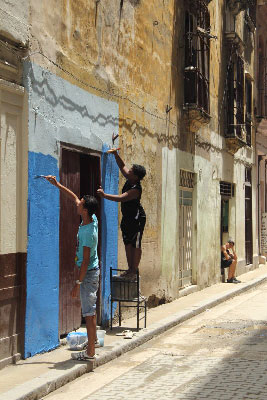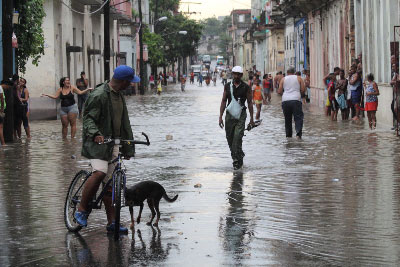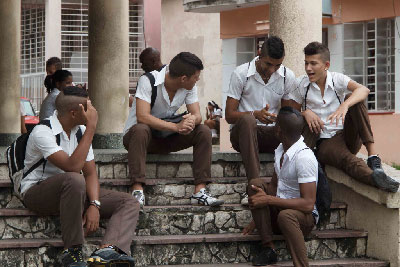Race as a Challenge to Cuba’s Educational System
By Esteban Morales*

HAVANA TIMES — Before the start of Cuba’s 2013-14 school year, ministers and officials from the country’s education ministries met to evaluate the situation of the country’s learning institutions.
If you asked me, I would say that the Cuban revolution’s two greatest achievements have been Cuba’s educational system and developed scientific sector. Nothing accomplished to date outshines them in terms of merit and results.
Unfortunately, none of the speeches delivered at the meeting or the documents published by the Cuban press touched on an issue that I consider of the utmost importance: the question of “color” in Cuba’s education system.
Cuba’s is a multiracial society. This issue, however, is nowhere addressed in the country’s study programs. This holds for junior, senior secondary and higher education.
The issue isn’t only passed over in silence at the different classes and lectures students attend; it is also alarmingly absent from our history and other textbooks.
Our teachers and professors also tend to skirt issues related to the histories of Africa, Asia and the Middle East, issues that are closely linked to Cuba’s racial question.
The issue of race, to be sure, should not be regarded as an educational concern exclusively. It should, rather, be taken on as something that concerns the whole of society, which ought to work to educate students and the people in general, in this area of crucial importance.
In Cuba, racial stereotypes, discrimination and racism are not institutional – they are not the result of a policy that defends or encourages these practices through an official, political structure.
That said, Cuba’s institutions, which ought to help us in our struggle to turn Cuban society into a harmoniously multiracial or multicolor community, are not yet doing as much as they should in this regard.
This stems, in part, from a lack of political will and an excess of bureaucratic hurdles, coupled with inexplicable delays in the search for solutions to this pressing problem that has such a profound impact on the country’s efforts to ensure social equality.
In recent years, Cuba has begun to address this situation through coordinated, collaborative efforts headed by the Cuban Writers and Artists Association (UNEAC), aimed at meeting the country’s needs in this area through broad-encompassing efforts.

The four fundamental institutions (the quadrangle of social forces) that ought to be targeted by these efforts, in my view, are the following:
– School, understood as all levels of education and training.
– The mass media, understood as the press, radio, television, cinema and all mechanisms used to divulge and disseminate information.
– The national statistics system, whose mechanisms for collecting and processing economic and social information are essencial for creating a database that will allow us to address the racial issue at the national level and at all levels of education and scientific research.
– Science, understood as a process that contributes to general research and to laying the foundations of our society’s knowledge. The social sciences and the humanities are particularly important for addressing the racial issue in a comprehensive manner.
These four areas must be targeted if we want to make any headway in the struggle against racial discrimination and racism. To design social policies that can eradicate these problems, we need to move towards a more systematic and scientific approach to the issues.
The multiple connections between these institutions, which constitute the cultural context of the problem, could be said to be a fifth, catalyzing element.
It will be impossible to truly raise people’s awareness about the multiracial nature of our society, let alone eliminate racism, if citizens aren’t considered an integral part of these processes and if we do not target our educational system, for, whatever isn’t taught at school does not generally become a part of our culture.
What we need is an anti-discriminatory and anti-racist culture that will make our society more conscious of the stereotypes that persist among us and thus more equal and just.
Our educational system faces yet another problem, one closely linked to those described above.
The excessive emphasis on Western values that our education – and Cuban culture in general – still relies on constitutes an obstacle in our efforts to create a more open and broad-encompassing culture, expressing itself in the lack of balance that exists among different racial groups in Cuban society today.
This lends significance to the debate surrounding the persistent hegemony of Cuba’s Hispanic heritage over all other traditions, particularly African ones, which continue to endure the stereotypes, marginalization and discrimination of a considerable part of the population.
Our students have relatively easy access to Spanish, Hispanic and European literature and to much of the culture of these different parts of the world. They know practically nothing, however, about Africa and its contemporary culture, less about Asia and much less about the Middle East.
After completing their junior and senior high school studies they go out into the world with an incomplete, biased, racist and Manichean vision of Cuban culture.

They also enter university with a blinkered and sterile idea of what universal values are, that is to say, with a rather incomplete and distorted image of Cuban culture and what its roots are.
What’s more, they complete their education without knowing the reasons behind the racial diversity of their classes and the cultural differences that occasionally manifest themselves among students, let alone their individual behavior, religious beliefs and other values.
They leave school, in short, without having gotten to know each other well, as the members of one community, and this quite simply because the system has avoided offering them a rational explanation for the racial, color and cultural differences that exist in the country.
It would seem, in fact, that we are educated, not to become Cubans, but to become white people. Such an identity is dangerously less complex and important for us, who ought to assimilate the intricacies of Cuban culture – if we wish to become the citizens of a multiracial community, that it is.
The most serious consequences of this is that those who are educated to become racists continue to be racists thereafter, and those who are not racist owe their condition to personal preoccupations, family circumstances and different forms of social contact.
These trends, however, do not appear to be shaped by education, a space in which the positive ought to be emphasized and stereotypes, prejudices and discrimination flushed out.
Since stereotypes, discrimination and racism do not stem exclusively from ignorance but also depend on the social and family circumstances that shape an individual’s views, we are still not in a position to be able to know if, by the time these individuals finish their studies, they go out into the world as the responsible citizens we need.
That said, the new generations appear to be making progress in this regard, to mingle more freely, with less reservations about issues of race. The problem often arises, in fact, at the family level.
To prevent this, we cannot leave things in the hands of chance. We must impel a process as a society, from the top and from the bottom, that is to say, treat society, individuals and families as a whole.
Jose Marti expounded on countless ideas and social behaviors – which he exemplified with his own life – that could extirpate racism from social consciousness. It seems, however, that, in this battle, Jose Antonio Saco, with his concept of a white Cuban community exclusive of blacks and his ideal of purifying the race, continues to be winning.
The racial stereotypes we continue to endure, discrimination and racism, more than problems inherited from Cuba’s colonial and republican times, are phenomena that stem from the imperfections of our society, sustained by the general imperfections of our educational system.
—–
(*) Visit Esteban Morales’s blog in Spanish.






On this topic Mr. Morales is at his best. His ability to zero on the problems of racism that continue to permeate Cuban society should remain the centerpiece of his writings. When he has ventured into opining on US policy, he has failed miserably. However, he is “in his lane” in this article. He writes, “It would seem, in fact, that we are educated, not to become Cubans, but to become white people.”. Well said.
Racism is endemic in Cuba. It was also institutionalized in certain laws.
in 1997, Castro implemented Decree 217, which was designed to “control the migration flow from poorer provinces to the capital city of Havana.” In effect, this specifically targeted the poor black and mulatto population concentrated in the eastern provinces. “The decree also resulted in numerous credible reports that said many desperate blacks and mulatto squatters, not having official permission to reside in Havana under Decree 217, are forcibly evicted from their homes and sent back to the countryside.
http://www.cubanet.org/CNews/y01/apr01/10e6.htm
More on the decree:
http://cubaverdad.net/freedom_of_movement.htm#1._Right_to_freedom_of_movement_and_residence_within_Cuba._
More on racism in Cuba: see
http://cubaracismo.impela.net/
Your system is screwed. Better if we could edit if need be.
Appreciate your article. Race is a complex issue and any discussion about it often gets off on the wrong foot. Consider that as a species human beings are actually of one race, not four in terms of White, Black,Brown and Yellow. We are not colors. Racism can mean the assumed superiority of humans over other animals. Is not all life sacred? Thus, we must ask: What is a race?
Race as commonly understood and discussed is a man-made invention. Perhaps the first racist were the Spaniards against Native-Indigenous peoples or those called Native-Americans. I am a Chicano de Aztlan or what can be considered a Mexican-American. Thus, it is not all black-and-white.
Many times we are dealing with manifestations of ethnic bigotry or reactionary culturalism. Thus, race as a topic can be complex and multi-layered.
Peter S. López aka @